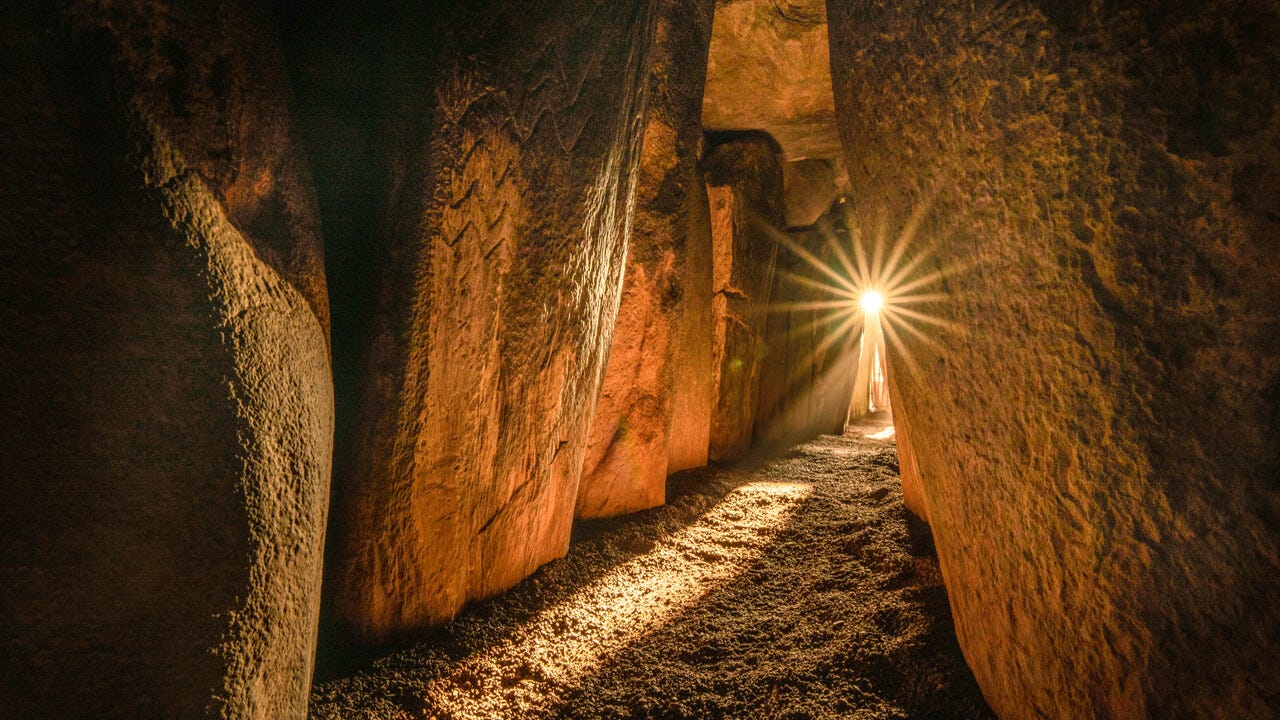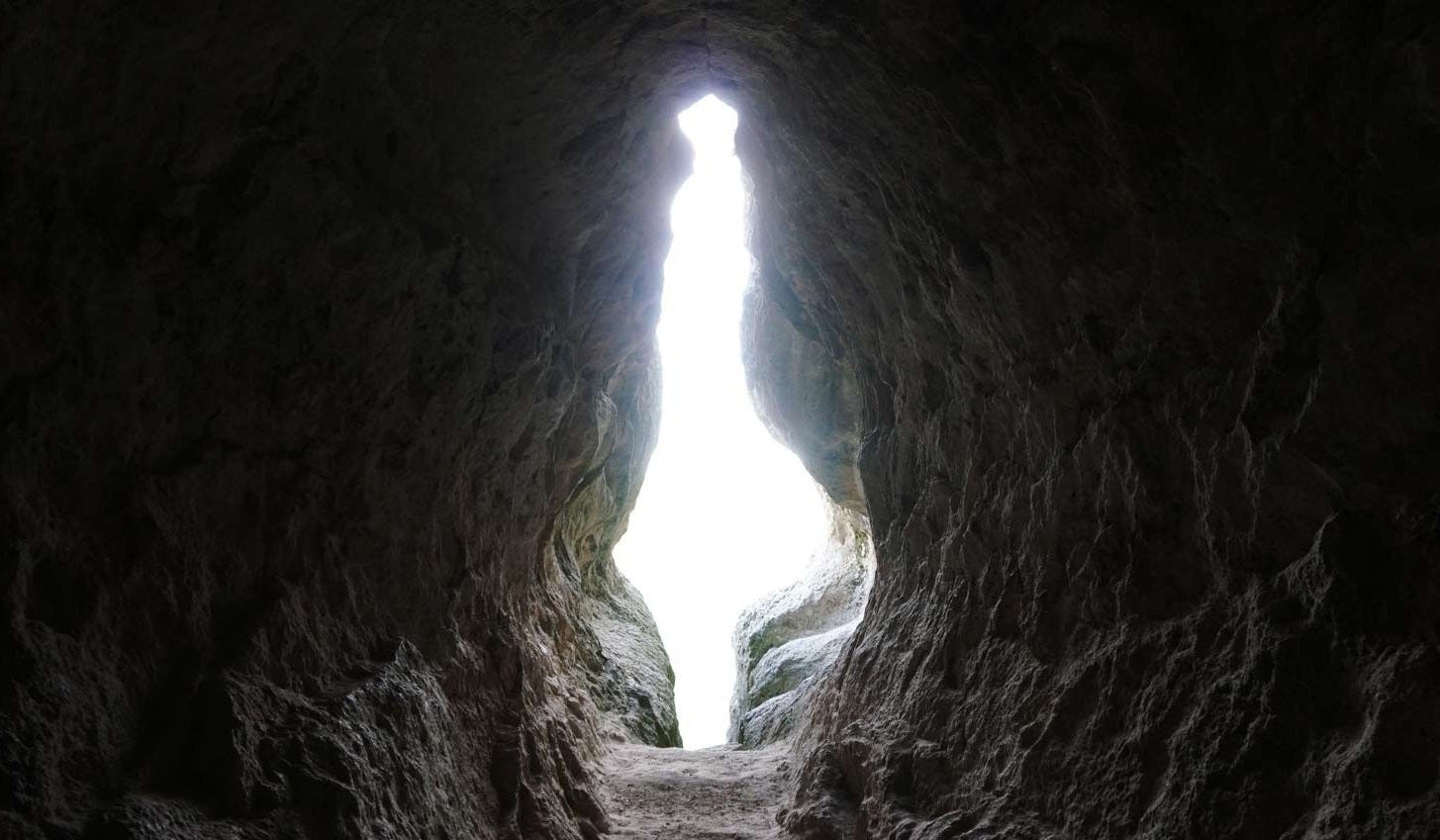The Roots of Winter Solstice Ritual
Symbols of light born out of darkness echo in our collective consciousness. How did they begin?
In the depths of an Ice Age winter in the Northern Hemisphere, a fire flickers in the mouth of a cave. Around it, shadows dance, and in those shadows, meaning emerges. Here, deep in the frozen heart of the Paleolithic, Neanderthals gathered—their breath steaming in the cold air, their minds turning toward the slow retreat of the sun and the promise of its return. It is these moments in which the seeds of the winter solstice festival began to grow roots.
We know only fragments of what Neanderthals left behind: ochre-stained bones, burials with symbolic arrangements, cave art, and enigmatic bear remains in secluded recesses of their dwellings. But their symbols resonate with themes that ripple through the myths and rituals of humanity's later civilizations. The cave, often aligned with the sun's rising light, became a womb-like space of transformation and renewal. The bear, feared and revered, performed a pantomime of death and rebirth, disappearing into its den only to emerge with the thaw alongside newborn cubs. The sun itself set the stage on its annual journey for the hero’s journey. These symbols would echo through time, carrying forward the unspoken questions of continuity and the meaning of life’s cycles.
The once unknown but speculated common ancestor of Northern cultures, who could explain the unmistakable overlap in myths and traditions including those surrounding the winter solstice, might be right under our noses in the form of the Neanderthal. The solstice solar alignment in the monuments of Ireland and Egypt, the Great Bear name shared cross-continentally, and the divine child and wise old man archetypes, all share one definite prehistoric trait: Neanderthal ancestry.
Caves, the Rising Sun, and the First Temples
Neanderthal caves, often carefully chosen for their position relative to the sun, hint at an awareness of light and its symbolic power. Some caves seem oriented to catch the first rays of the solstice sunrise as if to capture the birth of light from the womb of darkness. Millennia later, humans built temples with similar intentions—Stonehenge, Newgrange, Karnak. But where temples stand as deliberate constructions, the caves of the Neanderthals were sanctuaries shaped by nature, imbued with meaning by observation and use.
The archetype of the cave as both tomb and womb took hold in the human psyche. Later myths carried this duality: the hero descending into darkness only to emerge transformed, the child born in a hidden place destined to bring salvation. The cave became a universal stage for the human drama of death and rebirth, and the bear its main influence, whether in the myth of Orpheus or Christ’s resurrection:
"Orpheus’ descent into the underworld and his eventual successful return represents a model borrowed and adapted from prehistoric bear ceremonies...In Christianity, Christ’s descent into hell mimics Orpheus and thus the bear.”1
The Bear as a Symbol of Rebirth
Among the symbols that survive from Neanderthal life, the bear looms large. Excavations at sites like Drachenloch and Le Regourdou have revealed bear remains carefully arranged, as if in reverence. This veneration is echoed in later myths across the cultures of the Northern Hemisphere.
Tales that fall under the Bear’s Son myth archetype share a theme: a bear deity descends from the stars to the earth and mates with a human woman, much like the sun’s rays shining through a cave opening on the solstice, or the angel visiting Mary at night with the news of immaculate conception. The woman gives birth to a heroic, divine or semi-divine child who elevates humanity’s understanding of the world.2 Over time, the Bear’s Son was replaced in mythologies by human images, such as Artemis and Arthur (both names derived from “bear”), yet the archetype’s essence persists.
It is striking to consider how this myth echoes across time, even finding resonance in the story of Jesus. Like the Bear’s Son, Jesus’ divine conception, birth in humble circumstances, role as a teacher and savior, and sacrificial death carry forward these themes of celestial origin and earthly transformation. The bear’s connection to the solstice—the time of the sun’s rebirth—reflects an ancient understanding of cyclical time, of the interconnection between light, darkness, and the rhythms of nature.
The Divine Child: Light Born in Darkness
From the womb of the cave and the hibernation of the bear emerges another archetype: the sacred child that, like the sun, is born at the time of the winter solstice. This figure appears across cultures, from Horus in Egypt to Mithras in Rome, from Apollo in Greece to Christ in Bethlehem. Always, the child represents the spark of life amid darkness. In this narrative, the winter solstice becomes not just an astronomical event but a symbolic affirmation of resilience in rebirth.
These divine children often share a similar fate. Born in humble or hidden circumstances, they rise to prominence, embodying vitality and hope, only to meet a tragic end that secures their place in the cosmic order. Christ, Osiris, Tammuz, Orpheus, Baldr—each is a figure who shines brightly in life before succumbing to death, their stories bound to cycles of decay and regeneration. They are the strong young gods, often referred to as Shining Ones, who represent, in part, the reborn sun. Their skin or clothes are described as bright and glowing, their features fair, and often their names etymologically are tied to one of these adjectives as well. Their deaths are not final; they herald renewal, the continuation of life, the youthful manifestation of the ancestors or gods, the triumph of light over darkness.
The symbolism of the Shining One reflects humanity's deep psychological response to the mystery of creation and the divinity of nature’s cycles. Just as the sun is reborn at the solstice, so too is the divine child a metaphor for the ever-returning light. This archetype may find its earliest expressions in the observations and rituals of the Neanderthals, whose survival depended on understanding these cycles and committing their knowledge to collective memory. The firelit cave—a sanctuary against the cold—may have been the first cradle of this idea outside of the sun itself. The fetus—whose skin in the mother’s womb is covered with nerve endings—similarly “shines” in all directions: both images of the interplay of light and darkness, both giving rise to the stories we still tell and rituals we still participate in.
Symbols Without Memory
Today, we celebrate these ancient ideas without fully understanding them. We bring trees into our homes and place them near chimneys, adorning them with lights and gifts. We wrap presents and exchange them, honoring traditions whose origins we attribute to Christianity or commercial invention—but which stretch much further back. The Christmas tree, the Yule log, the act of gift-giving—these symbols carry echoes of the solstice rituals of our ancestors, yet their meanings have become opaque.
“At Christmas we may express our inner feeling for the mythological birth of a semi-divine child, even though we may not believe in the doctrine of the virgin birth of Christ or have any kind of conscious religious faith. Unknowingly, we have fallen in with the symbolism of rebirth. This is a relic of an immensely older solstice festival, which carries the hope that the fading winter landscape of the northern hemisphere will be renewed. For all our sophistication we find satisfaction in this symbolic festival.”3
Why do we cling to these symbols, even when their original purpose has been forgotten? Perhaps it is because they speak to something primal within us. They remind us, even unconsciously, of our place in a world governed by cycles of light and darkness, death and rebirth. They connect us to a lineage that stretches back not just to the first civilizations but to the caves of the Neanderthals, where the flickering firelight first transformed darkness into meaning.
In carrying forward these rituals, we perform a uniquely human act. Other animals alter their behaviors in tune with the winter solstice, but only humans mark it with ceremony and symbolism. Only we carry forward traditions whose meanings we no longer fully understand, connection through the act of remembrance. This is both a strength and a mystery—a reminder that we are creatures of the earth and yet something more.
To search for the origins of the winter solstice festival is to search for ourselves. It is to peer into the shadows of deep time, where Neanderthals lit fires against the dark, perhaps wondering, as we do, about the sun’s return. It is to ask what it means to be human, to carry symbols whose roots stretch beyond memory. And it is to marvel at the persistence of light—in the darkness of winter, in the depths of prehistory, and in the caves of our minds, where the ancient fire still flickers.
Shepard, Paul, and Barry Sanders. The Sacred Paw. Viking Adult, 1985, p. 131.
“The Grove of Manannan Mac Lir Grove - Winter Solstice.” 2024. Druidry-Sfbayarea.net. 2024. https://www.druidry-sfbayarea.net/The_Wheel_of_the_Year/Winter_Solstice.htm.
Jung, C G. (1964) 2013. Man and His Symbols. Bowdon, Cheshire, England Stellar Classics.



